November 30, 2005
East Kimberley art: Freddie Timms
I only managed to catch a quick glimpse of the exhibition of the art works by the indigenous partists from the East Kimberleys. I had time to located them, walk around the exhibition, before I had to move onto the vital issues seminar on health reform chaired by Carmen Lawrence in the Parliamentary Library.
I did notice the name of Freddie Timmsfrom the East Kimberly region:
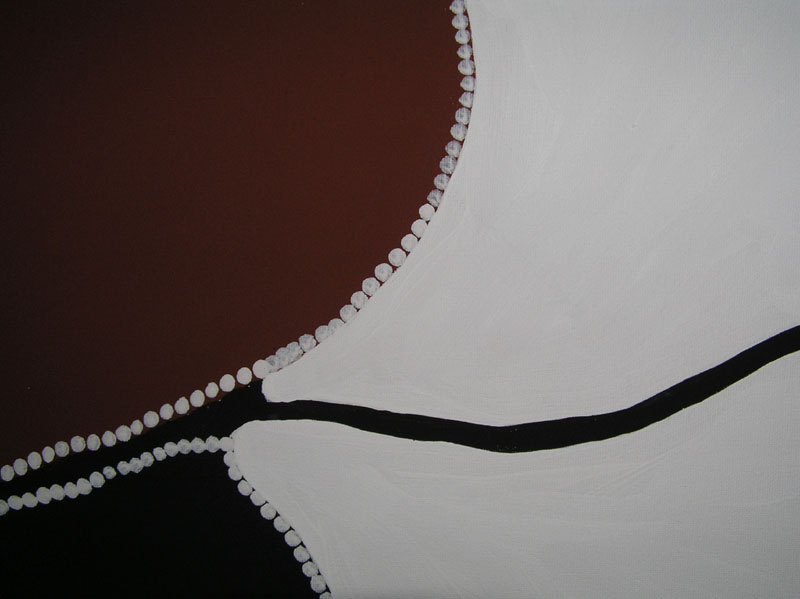
Freddie Timms, Moonlight Springs, 2001, Ochre on Canvas
Freddie Timms was born at Foal Creek on Bedford Downs Station south west of Warmun (Warrmarn - Turkey Creek). He knew Rover Thomas when they both worked at Bow River and Texas Downs and danced and help paint boards for early performances of Thomas's Gurirr-Gurirr. He paints in a style reminiscent of Thomas but recognisably his own, with expanses of plain paint lined with white dots.
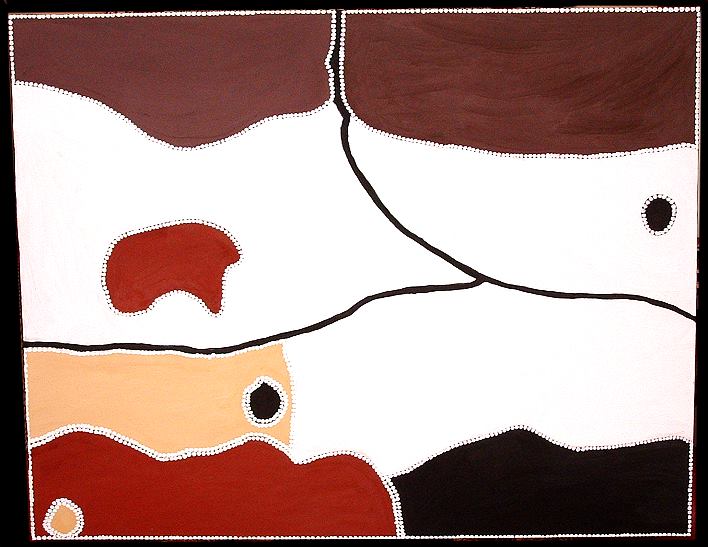
Freddie Timms, My Country, Ochres on linen
Many of his pictures are like aerial maps of the bones of the country where he lived and worked all his life. Mapping is on a topographic level showing features of the landscape such as black soil, red ground, sandy ground, hills, creeks and water holes as well as a historical and spiritual level showing roads, stock yards, homesteads and dreaming places. Much of the country where he worked is now under the water of Lake Argyle formed by the damming of the Ord River. He says:
"I think about the country where I was walking and camping, all the main water holes, all the camping areas. I remember the places where I used to go mustering and I follow them up with my painting."
November 29, 2005
East Kimberley art: Rusty Peters
I've read that there is exhibition of works from the Jirrawun Corporation on display in Parliament House, but I cannot find any images of the exhibition on line, nor a list of the artists involved.
I'm interested because the Jirrawun Corporation markets the work of the East Kimberley aboriginal artists whose work in the distinctive Kimberley style made famous by Rover Thomas, and Queenie McKenzie: sparse, flat expanses of natural ochres and minimal dotting to form bold, imposing images of country.One artist I do know who is exhibiting is Rusty Peters:
And:

Rusty Peters: Waterbrain
I'm going to Parliament tomorrow afternoon so I will try and find the exhibition, and maybe even write a review of it. If that is not possible then I wil post some of the images of the artists involved in the exhibition.
November 28, 2005
Max Ernest: two images
It is late and I've been up since 4am to catch a flight to Canberra. Something playful and whimsical:
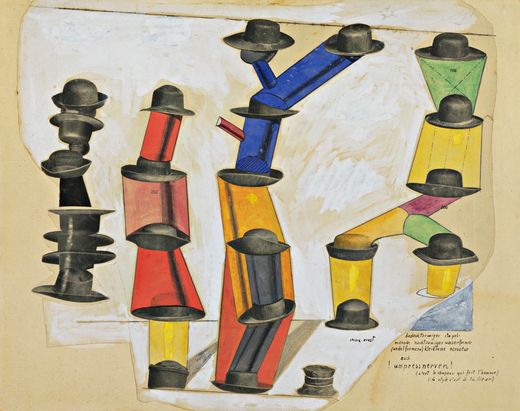
Max Ernst, The Hat Makes the Man, (1920), Gouache and pencil on cut-and-pasted printed paper on board with ink inscriptions,
Max Ernst (1891-1976) was a German painter, sculptor and graphic artist, a member of Dada, and a leading representative of Surrealism:

Max Ernst, Landscape with Sprouting Grain, 1936, Oil on canvas
This is the world of the unconscious. More here
November 27, 2005
writing the 1990s culture in Australia
How do we write a cultural commentary of the 1990s in Australia?
Do we organize it around the effects of the rebellious music of Australian punk, post punk/new wave or indy bands that flourished in the inner cities in the late '70s to mid '80's?
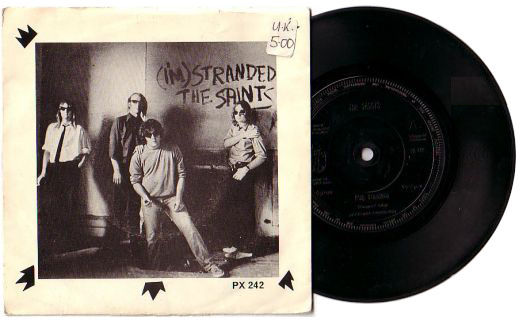
The argue that the alternative music became mainstream If so, then what effect does that music have on Australian culture in the 1990s?
Do we organize it around the Quadrant conservative's culture and anarchy meme? Or their postmodern surface withour depth
Do we organize it around the emergence of a visual culture and the displacement of a literary culture?
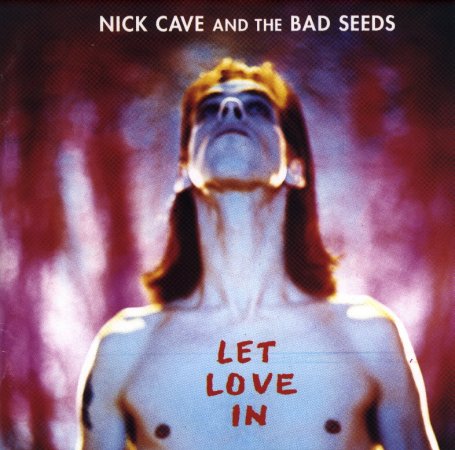
Should we write about Australianness in a globalized world?
Or sexuality:
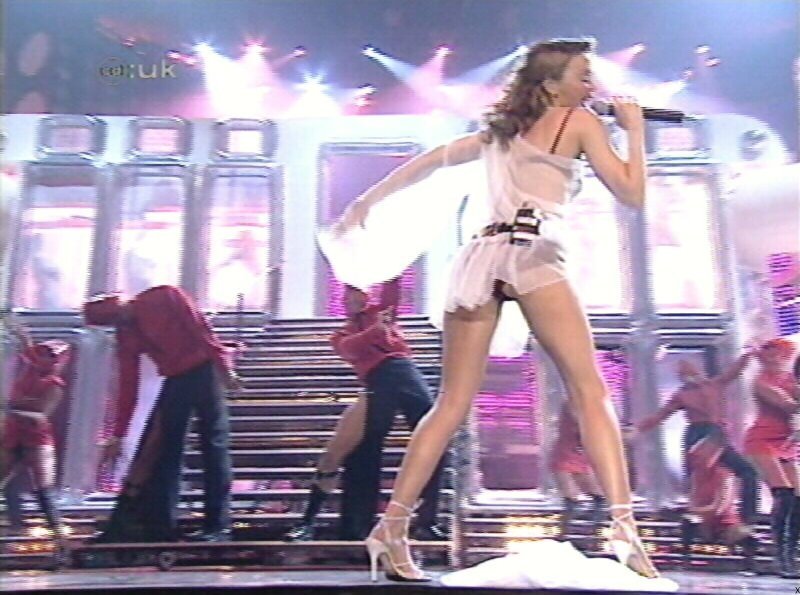
Or celebrity from a fan's passion that still burns?
I do not know the answer to these questions. Nor do I know any texts that do this. It seems to be accepted that if you want to understand the '90s then you have to understand the '70s as here was the first flowering of a distinctive and, finally, respected Australian music culture.
November 26, 2005
the Velvet Underground
I've always been a fan of the Velvet Underground. I've seen their music of 1967-70 as the representing the first real break from mainstream rock; music that is now seen as classic rock. I guess I have seen them as representing a paradigm shift in rock music signalled by the 1968 White Light/White Heat.
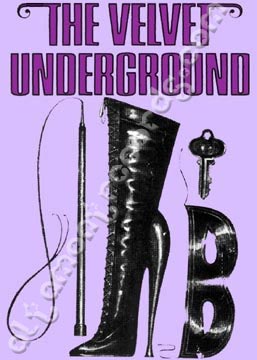 But then, I enjoyed the pop sensibility of the earlier The Velvet Underground and Nico with its pop art banana cover designed by Andy Warhol and its roots in Warhol's multimedia happenings--the Exploding. Plastic. Inevitable. This is where nihilism and degradation meet pop music.
But then, I enjoyed the pop sensibility of the earlier The Velvet Underground and Nico with its pop art banana cover designed by Andy Warhol and its roots in Warhol's multimedia happenings--the Exploding. Plastic. Inevitable. This is where nihilism and degradation meet pop music.
With these multimedia happenings Warhol used his celebrity and resources to sponsor and promote artists and collect them into a single, creative troupe, shielding them from the commercial film and music industry, thereby allowing them to create raw art free from commercial constraints.
I also enjoyed the return to pop sensibility in the 1969 third album, The Velvet Underground where Doug Yule, had replaced the experimental, avant-garde, dissonant John Cale.
I do not know Loaded or the 'lost album'- subsequently entilted VU. From all acoounts they mark the shift away from the experimental to pop/rock just like the Grateful Dead shift to Americana with their Workingman's Dead.
As Piero Scaruffi says the 'Velvets are the great poets of the metropolis. Their poetry is a continuous reference to the degradation of modern life, to the alienation of the city, to the existential desperation of chronic loneliness, to the moral and physical violence shared by an entire population of modern "losers." '
The conventional rock history runs like this:
While the American west coast was undergoing the Summer of Love, psychedelia and flower power, the typically east coast Velvets concerned themselves with darker subject matter: transvestites, heroin addiction, and sadomasochism. Also setting them apart from their contemporaries was their use of feedback and amplifier noise in a musical context, exemplified by the seventeen minute track "Sister Ray" from their second album.
This is revisionism. The maniacal Sister Ray was significant --it represented the wild anarchic dark side of rock, which was further explored by the Grateful Dead in Live Dead and
My approach sounds like a portrait of a rock snob doesn't it? You know the genre professors of pop, making their appeal to the eggheads.
Then again, punk was a paradigm shift in rock music; one that was initiated by the Velvet Underground Is this the reason they are seen by rock historians as 'probably the 'most influential band of the entire history of rock music, and certainly the most influential on the 1990s.' Punk is the defining moment in popular culture?
November 25, 2005
schoolies week
I'm down at Victor Harbor amidst schoolies week--the end-of-school holiday marked by freedom and letting your hair down.
Surfers is the Mecca. The real deal. It's where schoolies began. Schoolies 'week', has become a part of Australian culture - and 'become a tradition'. It's a rite of passage, a week in which thousands of young people head for Queensland's beaches to celebrate the end of their exams and the beginning of their new-found freedom.
Like the Gold Coast Victor Harbor braces for the schoolies coming down from Adelaide ---an invasion of about 10,000 teenagers in the next few days. Its big bucks for the town as it will be party, party, party because there isn't much of good night life in Victor.
Schoolies are a particular breed of sexual tourist---those into drug and alcohol abuse. The local authorities now run it as a festival with free gigs and volunteers keeping an eye on teenagers who might be partying a little too hard. Schoolies week is celebrated rather than feared.
November 24, 2005
West Wing
I've been watching early seasons of the finely-crafted "West Wing on DVD --the household is halfway through "season 2 that was aired in 2001. They are currently watching season 5 in the US, which does not involve Aaron Sorkin. He left at the end of the fourth season.
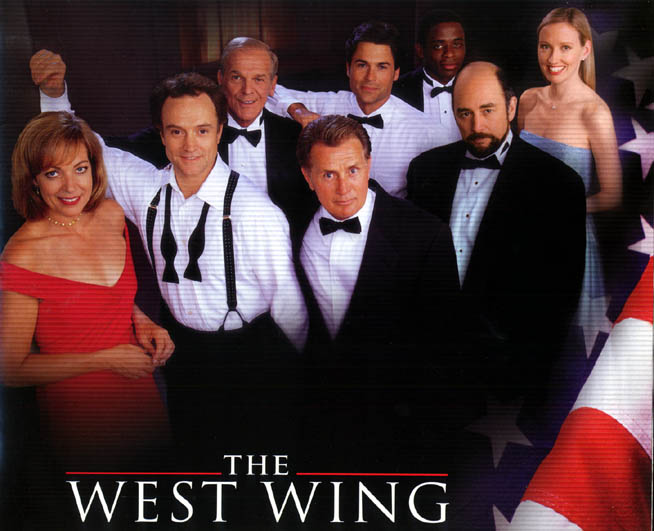
I find the stories about the lives of staffers in the west wing of the White House fascinating. One of the strengths of the show is the fine writing. I find that I can draw a lot of information from this entertaining television show, in spite of the slickness, the clipped conversation and Aaron Sorkin's the good goody liberalism of the staff and the more-than-human, heroic Democrat President. I did not see Sorkin's 1995 film The American President, or his latter work.
Information refers to the behind-the-scenes political activity behind the news events and the way that it caputres politics as a world. It is both TV drama and a commentary on contemporary U.S. politics. It's portrayal of the checks and balance system in the US Federal government is good as shows the way the Congress and the White House must work together, especially when the Democrat President is not elected with a mandate and the Congress is made up of a majority of the Republican party who have declared war on the President.
when in Rome?
The news reports are saying that city state of Singapore will hang a 25-year-old Australian man, Van Nguyen for the crime of drug trafficking in the next wek or so.
Nguyen was caught carrying 400 grams of heroin through Singapore's Changi Airport. He was in transit from Cambodia to Australia, had no previous criminal convictions, was carrying the drugs as a last-ditch effort to pay his brother's debts, and has offered police all the help they require in cracking down on drug syndicates.
No deal, even when the Australian government intervenes and advocates clemency for Van Nguyen.
The media construction of this event in Australia is that Singapore, unlike a civilized Australia, is bad because it trashs human rights. We don't hang people in Australia we just incacerate them for being asylum seekers.
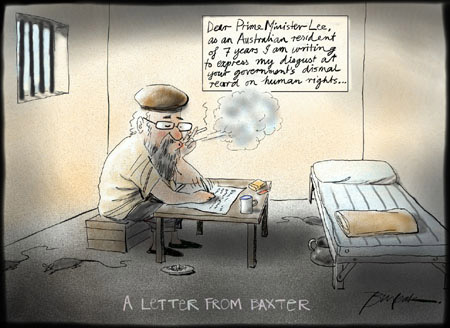
Bill Leak
I sense a whiff of hypocrisy in all of this.
Firstly, though Australians are unconcerned when the death penalty is applied to non-Australian citizens it is an act of barbarism when it is applied to Australians. Now, the death penalty is either right or wrong. It can't be right or wrong according to the citizenship of the person. There is a moral and political decision for Australia to take and, so far, we are trying to ignore it."
Secondly, are treatment of non-citizens borders on the barbaric. The risks that long-term or permanent residents run in failing to take up Australian citizenship are highlighted by this case. You can be rendered stateless by Australia. Even though someone like Robert Jovicic has lived in Australia almost all his life; his family is here, all his roots are here, he is seen as a non-citizen and an "alien".
November 23, 2005
open borders?
A visual representation of the tabloid Murdock media:
The tabloid media do not just represent or report on events such as immigation.They shape them, enframe the meanings of the 'boat people' and help to acutalize the events. The tabloid media have their own populist politics that scapegoat immigrants
November 21, 2005
Rover Thomas #2
This Western Australian Indigenous artist from the Kimberley region would have to be one of Australia's finest painters:
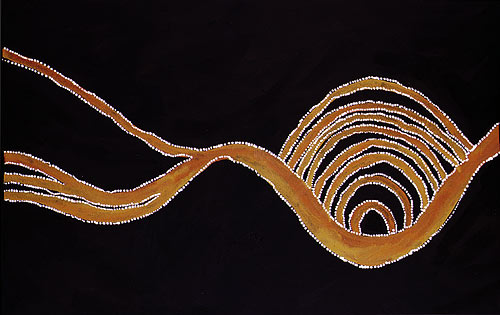
Rover Thomas, Bullock Hide Story, 1995
The abstract shapes condense complex mythological and topographical information into simple elements without the image ever becoming minimalist:
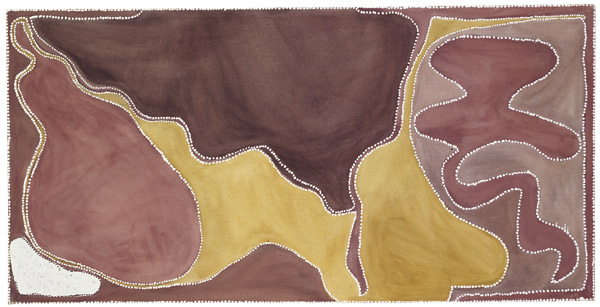
Rover Thomas, Bedford Downs massacre, 1987
I find the way large areas of the canvas are outlined and taken up by a single colour-- in contrast with the "dot" painting style typical of Central Desert artists--very appealing.
It does make you question aesthetic modernism doesn't it. This is a modern painting that discloses a world, and it provides a way to interrogate and critique a Kantian-style aesthetics that is based on a representational mode of thinking and which presupposes a subject object dualism.
That's an aesthetic mouthfuI I know. It just signposts where I am. I'll come back to it.
I raise it because liberalism in Australia sees the pre-modern aboriginal traditions as holding indigenous people back, rather than as sources of strength with the potential to change and adapt. Australian settler liberalism places an emphasis on the virtues of material progress through technology and capitalism, and so Liberals have difficulty understanding the position from which Indigenous Australians like Rover Thomas are coming.from. It is very difficult for contemporary Australian liberals not to think that Aboriginal society is backward.
The art says otherwise. It questrions the liebrla view that indigenous people are disadvantaged and backward people who need help to be brought up to ‘our’ liberal standards and take their place in the modern liberal world of modernity.
November 20, 2005
overcoming aesthetic modernism
Art is often seen as the viewer experiencing pleasure in the beauty of a particular object. 'Experiencing' involves sensation, taste, reflection and judgement that are held to be apart from our practical, moral or political interests. Those who write about aesthetics and know their Kant talk in terms of the 'autonomy of aesthetic judgement.'
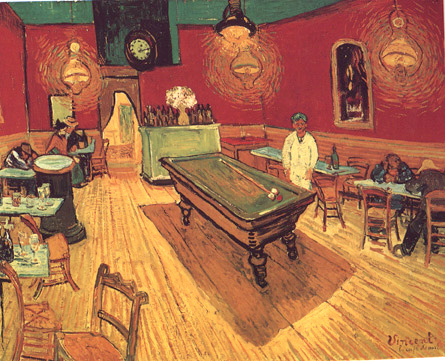
Vincent Van Gogh, The Night Cafe, 1888
Kant famously divorced the true (knowing) from the good (right action) and the beautiful and turned them into autonomous forms of discourse. Many have made Kant's grammar of aesthetics their own, embraced art's alienation from knowlege and morality, celebrated the historical emergence of autonomous art and aesthetics, and held that an modernist formalism is the high point of modernity.
So we can speak of the end of art in the sense that art is no longer for us the palce where truth occurs and is no longer formative of our experiences of ourselves and the world. Art is displaced from the centre to the periphery --as did religion in the transition to modernity.
So the overcoming of aesthetics can be interpreted as a twisting free from being imprioned in aesthetic modernity and a restoring to art works their status as forms of knowledge and ethics grounded in a community (sensus communis).
Can we engage with art in a manner that transcends the circumspection of art in pleasure and beauty and outside knowledge and ethics?
November 19, 2005
sedition #2
I'm in the Quantas Club in Melbourne airport. I've been in Melbourne for a couple of days for meetings about allied health care and health policy.
I could have worked at the hotel. But wireless broadband at the Hilton on the Park was expensive to use. So I decided to do my weblogs and have some nibbles at the Club, whilst I waited for my 6.30pm flight back to little old Adelaide.
I'm surrounded by a variety of magazines extolling getways and seductive luxury escapes. I just want to go home to be in my place for a week.
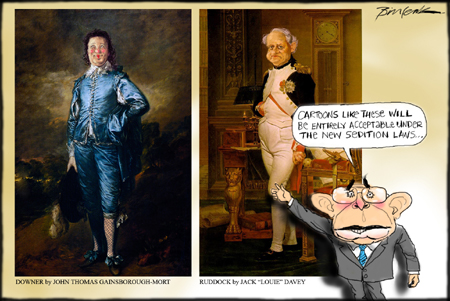
Bill Leak
Cheeky portraits of our Government politicians eh:--a satire on the work inside the National Portait Gallery.
Australian cartoonists are not convinced that the new sedition laws will not be used to clamp down on cultural critique, despite all the reassurances flowing from the Howard Government on this. Bill Leak is right.
Melbourne has changed a lot. It has got a lot bigger and there are lots of new commerical buildings going up in the CBD. On Friday I strolled through Fitzroy Gardens and "East Melbourne, where I once lived in the late 1970s, when I worked on the Melbourne trams and studied photography.
November 17, 2005
Great Barrier Reef: coral bleaching
This is a quick post on greenhouse and corals in Australia as I returned from Caberra last night and I've got to catch a plane to Melbourne.

The argument:
Queensland's mains power is mostly produced by burning coal. Coal is a fossil fuel. When coal is burnt, large quantities of carbon di-oxide and other greenhouse gases are released into the atmosphere. These greenhouse gases cause global warming and that this could lead to harmful changes in our climate. Global warming can lead to increased sea temperatures which can increase the frequency of coral bleaching.
Queensland has a problem as this bleaching process is happening to the coral on the Great Barrier Reef:

That undercuts the tourism industry. Who wants to see dead coral?
An article in The Age from its 'icons under threat' series spells the argument out.
Update: Nov 20 2005
The Age article by Melissa Fyfe says:
The problem with global warming and coral is quite clear and undisputed scientifically. With a mere 1 to 2-degree rise in temperatures, the colourful plant part gets booted out, leaving the coral appearing bleached. The animal part is then left to starve to death if the heat persists. Exactly why this breakdown happens is a mystery that science is trying to solve....While there is some scientific debate about the ability of coral to adapt to rising temperatures, researchers know even this increase is too much for the reef. Even the Great Barrier Reef Marine Park Authority has said as much. The authority is concerned that bleaching could be an annual event by the middle of the century, but some of the world's leading coral scientists believe it will come much earlier.
November 16, 2005
Empire days: a tourist in Canberra
I had an afternoon to myself in Canberra after the health conference finished. So I went to explore old Parliament House with my partner. I have worked in Canberra for several years and I've never had time to go visiting. It has always been a case of fly in, work long hours, fly out.
I had a lovely time wandering around the narrow corridors and small rooms of old Parliament House reconnecting with the various representations of political history that I knew from books, newspapers and experience. It was quick as I needed time to explore the National Portrait Gallery and work my way through a Cecil Beaton exhibition.

Cecil Beaton, Marilyn Monro, 1956
Tis elegant and glamorous isn't it. That's Beaton. His world was one of high society, theater, and glamour. Beauty in his hands was transformed into elegance, fantasy, romance and charm.

Cecil Beaton, Audry Hepburn, 1954
Caught up in nostalgia for an elegant and glamourous yesterday we went to the Hyatt Canberra for a gracious afternoon tea in elegant gracious surroundings that reminded me of the Raffles of Empire days.
On the walls I saw Walter Burley Griffin's 1912 drawings for Canberra. These were a long way ahead those of his competitors which looked quite kitsch. Griffin's designs were very much a part of the City Beautiful and Garden City movement: green bands surrounding areas of settlement, wide boulevards lined with large buildings, formal parks and water features. It is good to see the Griffins celebrated.

Walter Burley Griffin, design drawings, Canberra, 1912
Thanks to WB. Griffin Canberra is a lovely city. I love my little work world constituted by the Kingston/Manuka and Parliament House circle----the Canbera equivalent of the "Westminster village" which is the British equivalent of the "Washington beltway". The Canberra circle is a very pleasant part of the capitol.
In a city of circles designed for travelling by car, I can get around this tree lined circle without needing to own car.
November 15, 2005
sedition
The Howard Government is basically demanding unfettered executive power to fight the war on terror:
Under existing law a prosecutor must prove that any seditious conduct was done with an intention to create violence or disturbance, but under the proposed changes those provisions would be removed.
Is this demand under serious challenge”from those who are not seen to be wishy-washy liberals?
November 14, 2005
just an ordinary man
It is Sunday and it is time for something different from all the Canberra poiltical stuff of late. Maureen Dowd's Are Men Necessary?
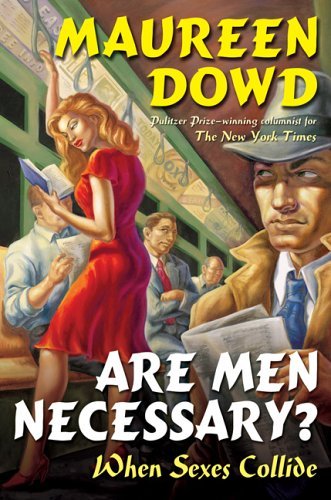 Dowd is a succesful single woman and she argues that men dumb down when looking for love. That cover says talented women have to act dumb and dress like a tart to 'catch' their husbands.
Dowd is a succesful single woman and she argues that men dumb down when looking for love. That cover says talented women have to act dumb and dress like a tart to 'catch' their husbands.
Dowd is the only female op-ed columnist at the New York Times. That's a real suprise, isn't it.
She writes:"The aroma of male power is an aphrodisiac for women, but the perfume of female power is a turnoff for men" she wrote. So we end up with lonely career woman too successful for love. That is reminiscent of Ally McBeal.
Who am I to judge? I have no connection to the world of the Washington/New York cultural elite that Dowd inhabits and I've no idea how gender looks to these hotshot women.
What is being pictured does sound like the 1950s to me:
"Deep down all men want the same thing: a virgin in a gingham dress," or "if there's one thing men fear it's a woman who uses her critical faculties."
All men? Its kinda cartoonish. What kinda man is Dowd looking for? Does she have man trouble? Hell, her romantic fantasies are about being Katharine Hepburn with Cary Grant, Ginger Rogers with Fred Astaire etc.
But we do live in conservative times, so maybe submissiveness is the new sexy? Recycled 1950s sounds like a turnoff to me. Then again that it is the conservative backlash against second wave feminism isn't it.
Maybe the text is a scintillating provocative critique of modern gender relations, dressed up in a pulpy cover.
November 13, 2005
political art & aesthetics
There is a discordance between art and truth that goes back to Plato's explusion of the poets from the polis in The Republic.
The expulsion of an autonomous post-Christian art constitutes modernity. Here art is taken to be outside truth and reason in the discourse of aesthetics, and so it conventionally becomes only art, mere art and a matter of taste. Tis the consequence of positivism many say
The effect is the alienation of art. Tis science that speaks of truth whilst it is religion that speaks of morality. Art is personal taste--what I like. These are the signs of modernity.
What if art speaks in its own voice in post modernity?
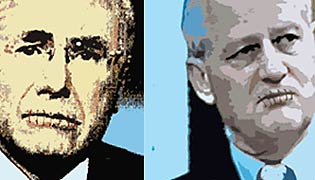
Michael Agzarian, digital image, 2005.
An exhibition of Digital portraits by Michael Agzarian at the Wagga Wagga Art Gallery show the Prime Minister (John Howard) and senior ministers (Attorney General, Philip Ruddock and Immigration Minister, Amanda Vanstone) with their lips sewn together.
Link via Barista, Daily Flute and Road To Surfdom
If art speaks in its own voice, then it does not speak truthfully or rationally. Something has gone wrong, for art does speak truthfully and it does speak about a better life than the one lived now. Maybe the discordance between art and truth (and goodness) is miscontrued in aesthetics? Maybe the conception of art outside truth and morality in aesthetic discourse is in need of a critique? A critique that understands art as historical--ie what it has been and will become.
What kind of history is that? Would it give rise to an aesthetic critique of modernity? One of remembrance, mourning and grief?
November 12, 2005
its a tabloid world#2
This is a nice comment on the trial by media noted in the previous post:
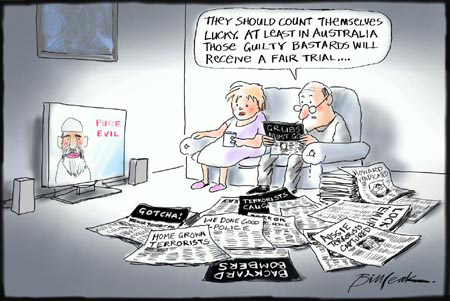
Bill Leak
The media---shock jocks of the airwaves, print-and television----do see the body politic being infected with hate for our way of life by the fanatical, extremist Muslims.
November 11, 2005
its a tabloid world
The media in Australia is clamouring---nay baying--- for blood. It is trial by media.
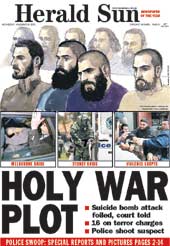
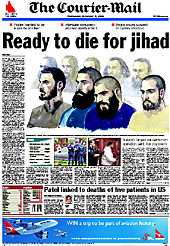
That's News Ltd for you.
They've been on the drip feed form the Howard Government and have had the inside information about the recent terrorism raids and arrests.
November 9, 2005
Jeff Wall interiors
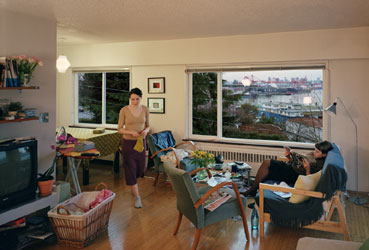
Jeff Wall, view from an apartment 2004-2005
This picture of an interior include a view is a synthesis of a commonplace interior that opens onto an urban panorama; it is documentary material thast is treated with cinematographic dynamism; the everyday is heightened through composition and the effects of light; and a narrative is suggested but left incomplete.
November 8, 2005
November 7, 2005
Rover Thomas plus
I don't read Quadrant often as I find its bland conservatism dreary. In the November issue there is an article by David Forster on 'Aboriginality and the Hope of Art.' He thinks that Western visual art is not just dead but putrescent. He then asks:
...could there be an interface in Australia between black and white cultures, of the kind that allowed for jazz in the USA? I'm thinking of an artist like the youthful Herbie Hancock. Could we come up with an equivalent? Probably not.
I'm interested in Forster says about visual art. He says that 'much contemporary Aboriginal Art , in my view, is opportunistic crap, but that's to be expected. '
Really? How about this? It's hardly crap.
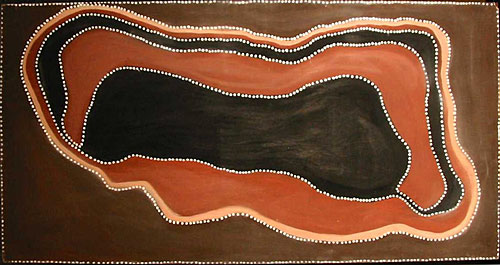
Rover Thomas, Lake Gregory 1985, Ochres on plywood
That is innovative. As is the work of Emily Kngwarreye:
Now Forster does give two examples ofAboriginal master works. One he mentions is 'Sandhills of Mina Mina' by the Warlpiri painter Dorothy Napangardi:
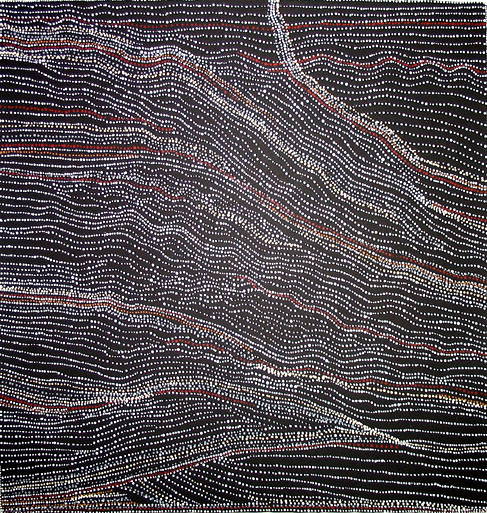
Forster suggests that works like this:
...suggest the future of Australian visual art, like that of dance, holds promise, because synthesis of the kind that allowed for the music of Duke Ellington are still possible, rather than probable.
I agree. But that is where he leaves it, just as it begins to get interesting.
November 6, 2005
John Spooner's political imagery
It's a helluva image. I just love the roadster as a symbol of the market's prosperity/consumer ethos.

John Spooner, Latham's Learners, Pen & ink & watercolour
It transcends its particular political moment of a federal election in 2004 to make a general point about the significance of education for the working poor, old-style blue collar industry workers, and the suburban aspirationals.

John Spooner, The Liberal experience, Pen & ink & watercolour
Australia does need to take the high skilled road to education if it is to continue to prosper. Most of the reform focus up to now under John Howard's Liberals has been on the low skilled and dumbing down education to the basics.
November 5, 2005
Mabel Juli
Tis simplicity itself.

Mabel Juli, Marranyji and Dinal 2004, Natural ochres on canvas
Probably the most famous Kimberly artist is the late Rover Thomas. For more than twenty years now other artists, and in particular, women artists have emerged and are gaining significant admiration and recognition. An example is the Aboriginal artist, Mabel Juli, a respected elder in Warmun, a community in the east Kimberley region of north Western Australia.

Mabel Juli, AM 296/02 2002, Natural ochre & pigment on canvas
Great work isn't it.
November 3, 2005
Jeff Wall
A mixture of cinematic and documentary tendences in photography:
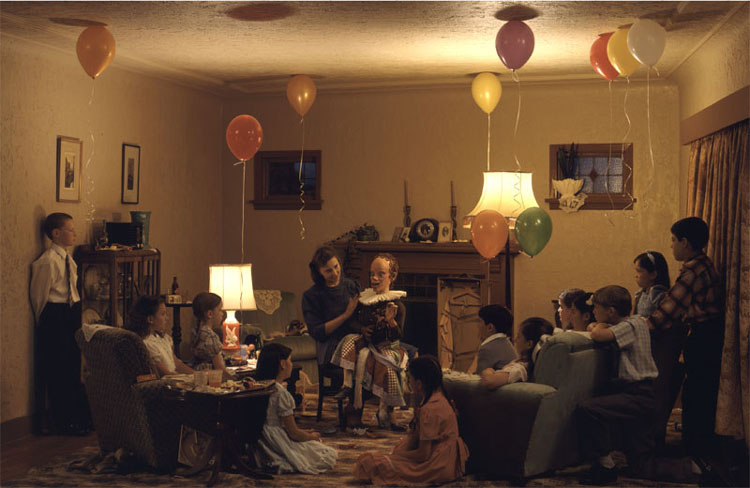
Jeff Wall, A ventriloquist at a birthday party in October 1947, 1990, Transparency in lightbox
The image is a mixture of the literary (Franz Kafka's short story 'The Cares of a Family Man'), film noir and the familiarity of the everyday. It creates claustrophobic and hermetic worlds of fantasy and strangeness.
November 2, 2005
on cue
It was right on cue.
The very day the anti-terrorism laws were due to be signed off by the haggling premiers up pops a credible terrorist threat to help push things along. Australian intelligence authorities had received specific information about a terrorist threat in Australia, the PM said. It could not have been better timed by Hollywood.
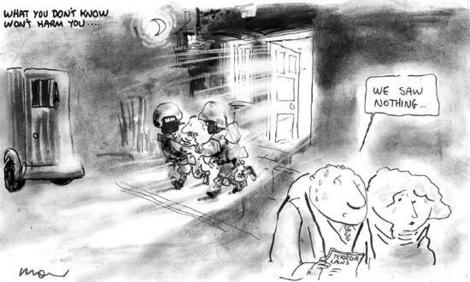
Alan Moir.
It could not have been better timed by Hollywood. It is stage managed politics. Howard has form on this. We will have these scares on an increasingly frequent basis I suspect.
Update: 3 November 2005
Margo Kingston smells a media scam. Reflecting on this I discern a, 'We know best and will only tell you what you should know when you should know it' line coming from the Howard government, ' that undercuts their 'Alert, not alarmed' message.
So I'll stick my neck out: 'there is no imminent threat of terrorist attacks in Australia.'
November 1, 2005
makes a point
I acccidently left my reading glasses in the Quantas Club back in Adelaide yesterday. I've worked all day without them in Canberra. My eyes ached, and I could no longer read words on the screen.
My eyes are still sore so a quick image:
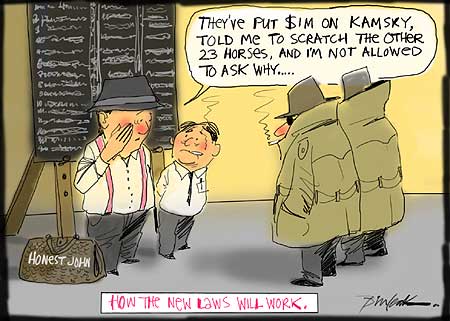
Bill Leak
The references are to here Tis a humorous way of making a serious point about the power of the spooks under the proposed anti-terrroism laws.
The race/bookie reference is to the Melbourne Cup--the race that a nation stops to watcch.
on a personal note my heart is behind Makybe Diva --she is the people's horse. I hope the mare wins for a third time in a row. If she does she will be the first horse to win three Melbourne Cups. History is against her. In the 144-year history of Australia's oldest and richest sporting event, no horse has won the Cup three times.
Update
The Diva did it.! The hattrick. I watched the race. It was over so quick. One minute the Diva was on the rails way back in the field , the next minuite she hit the front with 300 minutes to go, and that was that. It was history being written on tv.






